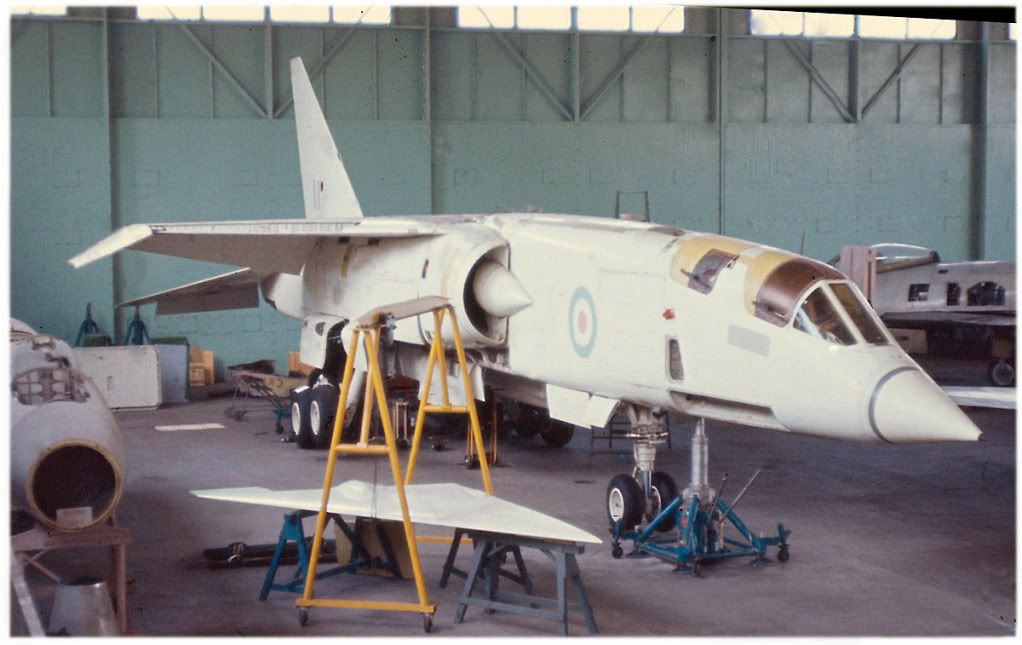- Yes
- No
Introduction: The Supermarine Type 545 is one of Britain’s “lost fighters”, never being able to explore its natural habitat in the air, despite being almost fully completed, due to a changing defence environment and politics. Despite this, the aircraft offered much potential, and would certainly be a great addition to the British tech tree, where it would be able to fulfil its role as a top-of-the-line predator.

Description: The Type 545 story starts out in 1950 as a further development of the Swift, which was still being developed. This was at a time when all of Britain’s aircraft manufacturers were spending great amounts of effort in trying to refine their current designs, in order to stay ahead of the game, and Supermarine was no different. Two designs were proposed: Stage 1 and Stage 2. Stage 1 was essentially a Swift which was modified with a new wing, with higher sweep. This was most suited at medium- to low-altitudes. Stage 2 was a very different beast; featuring a completely new crescent wing, and major redesigns to the fuselage. It was clear that Stage 1 would offer no significant improvements over the standard Swift, and it was decided to go ahead with Stage 2. This was not only just an effort to keep the Swift as modern as possible, but also to pre-empt any attempts by the Soviets at developing a new high-speed fighter. Geoffrey Tuttle emphasised the need for advanced types of current aircraft, specifically in regards to the Hunter and Swift. At this time, the latter was the preferred option. The prototypes were constructed from fuselage components taken directly from the Swift production line. The cancellation of the Hawker P.1083 put more emphasis on the Type 545, and a lot of weight was put behind its development. Design work moved ahead smoothly and a mockup was constructed. This was until the Air Staff began changing the requirements of the project, which increased cost; by a staggering 38%. This led to a complaint from George Edwards, who complained about the constant problem of having the requirement change while the project was already underway. In 1954, all-weather capability through the installation of Airborne Interception (AI) equipment was put forward. Mach 2 capability was mooted that year, which would’ve required a significant redesign of the airframe to incorporate a new engine. Despite this, both the company and the Air Staff thought it was reasonable. The prototypes under construction were capable of Mach 1.3, and could climb up to 51,000ft, with all-weather capability. The RAE was, however, quite doubtful in regards to the performance leap made by the Mach 2 variant which was under consideration, due to the amount of work required to get the 545 to that level of capability in only 2.5 years. The first blow to the program came when the second prototype was cancelled, though the RAE was happy to continue with the first one. However, this was also put in jeopardy, when it was realised that the 545 was delaying both the Swift F.Mk.7 and the Scimitar program as a whole, on top of which, the RAE began to lose interest. The research about the crescent wing was now considered to be surplus to requirements, as other programs had helped fill the gap in knowledge. Though there was some pushback to its cancellation, the order was given on 22nd December, 1955. The complete airframe was sent to the Cranfield College of Aeronautics, while parts and test rigs were sent to the RAE for research into materials.

Performance and Weaponry:
Spoiler
| Span: | 39ft 0in (11.89m) |
|---|---|
| Length: | 47ft 0in (14.33in) |
| Gross Wing Area: | 381sq ft (35.45 sq m) |
| T/C Ratio: | 7.5% mean |
| Gross Weight: | 20,147lb (9,139kg) |
| Powerplant: | 1x Avon RA.14R 9,500lb thrust (42.2kN) dry, 14,500lb (64.4kN) with reheat |
| Maximum Speed/Height: | 745mph (1,213km/h) at sea level, |
667mph (1,073km/h) at 45,000ft (13,761m)|
|Armament:|4x 30mm ADEN cannons|


Conclusion: Considering how close to completion the aircraft was, as well as its significance as one of Supermarine’s last products, I believe it would make a fine addition to the game, where it will be able to roam about the skies in the virtual world, allowing it to be brought back to life.
Sources:
Spoiler
“British Secret Projects 1: Jet Fighters since 1950” by Tony Buttler
Alternative Supermarine Swift Scenario / Type 545 | Secret Projects Forum
Supermarine Type 545 | Aircraft of World War II - WW2Aircraft.net Forums
Supermarine Type 545 Fighter Prototype - Destination's Journey





